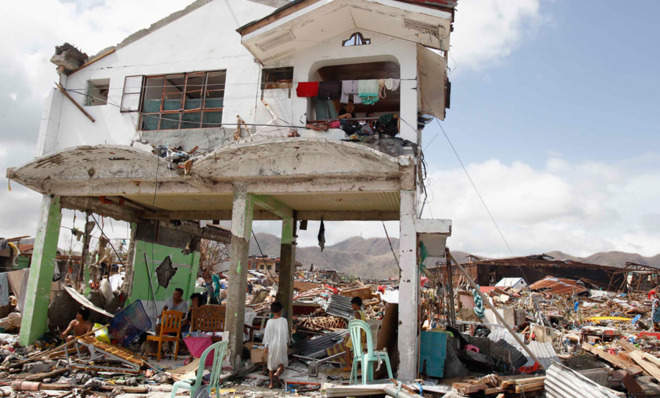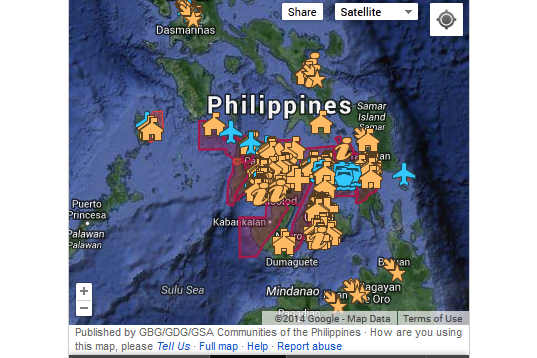Why Super Typhoon Haiyan caused so much destruction
A perfect storm meets a perfect storm
By Chris Gayomali | November 12, 2013
Most people by now have seen the splintered remains of the Philippine coastal city of Tacloban, on the northeastern corner of the provincial island of Leyte, which was decimated at the hands of Super Typhoon Haiyan.
What's perhaps most jarring to me, as a Filipino-American, aren't the corpses washed up along the highways, or the haunting remnants of living rooms cast against a grey sky; it's the photographs of what was, before the storm, a lush and vibrant metropolitan area teeming with life and color.

Where did it all go? While we have sadly grown used to seeing natural disasters flatten towns — think of Hurricane Sandy or the tornado in Moore, Okla. — the bleak images coming from the Philippines are of another order.
The numbers are bad. Many fear the death toll, hovering at 10,000 people, will climb. Between 600,000 to 660,000 Filipinos are currently homeless. Ninety percent of the housing is gone in some parts of the country. And, as my colleague Carmel Lobello points out, the road to recovery will be hard: Only an estimated 10 to 15 percent of the total losses in the Philippines are insured, compared to about 50 percent for Hurricane Sandy.
I've heard some wonder why more people weren't willing to leave behind their home and possession and seek safety. That's the thing: Many did. Philippine authorities moved 800,000 people to "sturdy evacuation centers" — brick structures like churches and public schools. Haiyan leveled them anyway.
Its record power and freak timing — Nov. 1 officially marks the end of typhoon season — are both outliers. And by almost every modern metric, Super Typhoon Haiyan was "the perfect storm," sustaining winds as high as 195 mph when it hit land, and gusting up to 235 mph.
The sheer force of the storm, as Richard Harris at NPR wrote, can be chalked up to "a series of bad coincidences":
Typhoons — known in our part of the world as hurricanes — gain their strength by drawing heat out of the ocean. Tropical oceans are especially warm, which is why the biggest storms, Category 4 and Category 5, emerge there. These storms also intensify when there's cool air over that hot ocean.
"The Pacific at this time of year is very ripe and juicy for big typhoons," says Kerry Emanuel, a climate scientist at the Massachusetts Institute of Technology. "Once or twice a year we get a Category 5 typhoon out there."
"But it's a great rarity, fortunately, that a storm just happens to reach peak intensity when it's making landfall. And that's what happened in this case."

Some climatologists and Filipino officials are already pointing the finger at climate change. But infrastructure problems and poor city-planning stemming from decades of government neglect played perhaps the largest role in compounding the damage.
The Philippines is supremely vulnerable to typhoons. The archipelago ranks atop the world's nations most prone to natural disasters, according to U.K.-based analysts Maplecroft. Part of the problem is its geography. The Associated Press reports that the country — which is made up of 7,107 islands — has "the lowest percentage of paved roads when compared with neighbors Indonesia, Malaysia, Vietnam, Thailand, and Singapore."
Not only does this make leaving Tacloban incredibly difficult — local papers report survivors congesting outward-bound highways on trucks, motorbikes, and foot — but it makes it near impossible for rescue efforts to reach the people wandering the streets for food and water.
U.N. officials report that making the 14-mile round trip from the airport to the main damaged areas to deliver food and supplies currently requires six hours due to debris clogging the roadways. "It's hard to prepare for the worst storm in the world," HSBC economist Trinh Nguyen told ABC News. "But at the same time one of the issues now is there isn't a way to access these places that are severely hit. The roads are not there."
Prior to Haiyan reaching land, the area scored extremely low in key indicators like fixed phone lines and households with stable electricity. Reaching people and organizing relief efforts has proven chaotic. "All systems, all vestiges of modern living — communications, power, water — all are down," Interior Secretary Mar Roxas said in a statement. "Media is down, so there is no way to communicate with the people in a mass sort of way."
With what little connectivity there is, Filipinos have converted their social media feeds into pleas for targeted aid.
Credit : http://theweek.com/article/index/252680/why-super-typhoon-haiyan-caused-so-much-destruction


































